
|
|
April 24 - May 15, 2002
WSM: The Biggest Blaw-Knox Of Them All
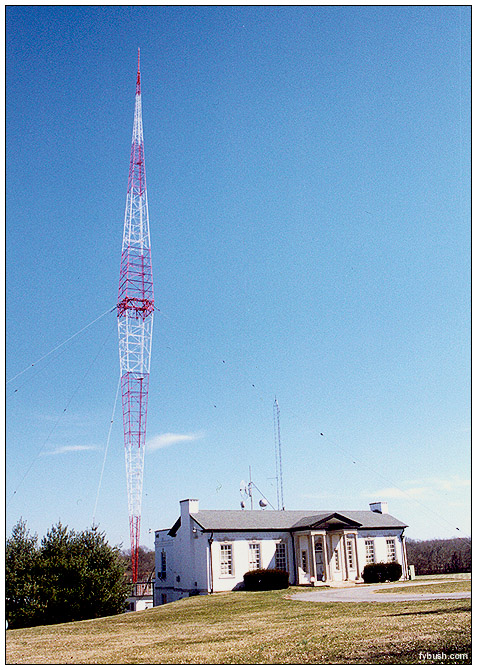 There are a few tower
sites around the country that every tower hunter should see at
least once in a lifetime. From New York's Empire State Building
and the AM towers of the New Jersey Meadowlands to Sutro Tower
in San Francisco, we've made it to most of them in the last decade.
There are a few tower
sites around the country that every tower hunter should see at
least once in a lifetime. From New York's Empire State Building
and the AM towers of the New Jersey Meadowlands to Sutro Tower
in San Francisco, we've made it to most of them in the last decade.
In a special category among those "must-see" sites are the five remaining Blaw-Knox diamond towers: WLW Cincinnati (as seen on the front page of fybush.com), WFEA Manchester, N.H., WBT Charlotte, WBNS Columbus -- and the biggest Blaw-Knox of them all: WSM Nashville.

We were fortunate enough to spend several hours at this gorgeous site in February, 2002, with WSM chief engineer Watt Hairston as our tour guide extraordinaire.
Come inside and take a look...
 That was the slogan
of the National Life and Accident Insurance Company, which put
WSM on the air from downtown Nashville in 1925.
That was the slogan
of the National Life and Accident Insurance Company, which put
WSM on the air from downtown Nashville in 1925.
Seven years later, WSM built one of the nation's first vertical antennas, contracting with the Blaw-Knox Steel Company of Pittsburgh to erect an 878-foot "diamond" tower (then, and for almost a decade later, the nation's tallest) on this site on Concord Road in Brentwood, Tennessee, about eight miles south of Nashville.
With a power boost the next year to 50,000 watts, WSM became one of the nation's strongest signals, reaching most of the country with the Grand Ole Opry (but no country music the rest of the week; that would come only in the seventies!)
While the vertical radiator and 50,000 watt signal worked well in Nashville and at night in most of the nation, WSM engineers soon noticed a problem with the signal: a ring of cancellation between skywave and groundwave signals at about 120 miles out -- which made the WSM signal hard to hear in areas such as Chattanooga and Knoxville.
In 1939, WSM's tower was shortened to 808 feet with the removal of a portion of the tapered top of the tower. (The portion that was removed was taken to a nearby school to be used as a flagpole; it remained there until 1996!)
At the top of the shortened tower, a new mast was installed with an antenna for WSM's FM sister station, W47NV at 44.7 MHz. That antenna and mast are still up there today, though W47NV ceased operation more than half a century ago, when FM appeared to be a failure as a medium. (WSM's current FM sister, WSM-FM on 95.5, came along in the sixties, operating from the guyed tower a few miles away that was home to WSM-TV, now WSMV, channel 4.)
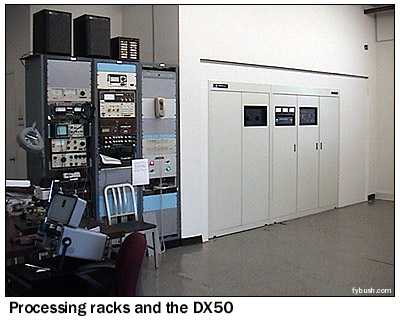

Check out that lobby - Watt has assembled a neat collection of old radios, equipment and photos. And you've got to love that "WSM" shield inlay in the floor!
There's a small kitchen off to the left and Watt's office off to the right - but walk straight ahead and you're in the large transmitter room. Old photos show a control desk surrounded by the racks upon racks of equipment that once made up a 50kW transmitter.
Today, of course, it's all solid-state, so there's plenty of empty space back here. On the left are the racks of STL, processing and measurement gear, including an Optimod processor and, yes, an AM stereo exciter.
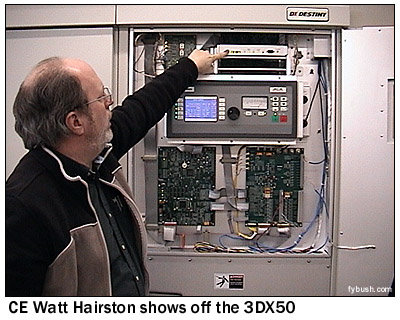
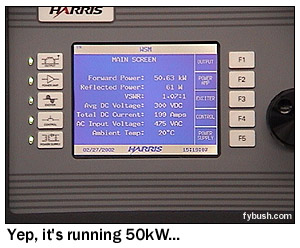 Next
to the racks is the Harris DX50 transmitter that's one of two
units now in use at WSM.
Next
to the racks is the Harris DX50 transmitter that's one of two
units now in use at WSM.
Across the room (past a row of big windows and a group of file cabinets with just about every blueprint for everything built at this site in the last seventy years) sits its newer cousin, a Harris 3DX50 ("Destiny") unit that went into service just last year.
As Watt shows us, the 3DX50 is all modular, allowing power units to be hot-swapped without shutting down the transmitter. And compared to the old tube transmitters, this unit is almost frighteningly efficient -- about 90% of the power that goes in comes out the other end as RF. Gone are the days when a big transmitter like this would obviate the need for a heater in the building!
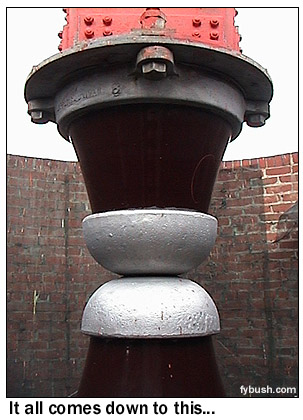 A spiral
staircase in this room leads downstairs, to an area now used
mainly for storage. There's a group of filing cabinets containing
the archives of the fight to keep the clear channels clear in
the sixties and seventies - and while we could spend hours going
through all the studies in there, there's a big tower out back
demanding our attention.
A spiral
staircase in this room leads downstairs, to an area now used
mainly for storage. There's a group of filing cabinets containing
the archives of the fight to keep the clear channels clear in
the sixties and seventies - and while we could spend hours going
through all the studies in there, there's a big tower out back
demanding our attention.
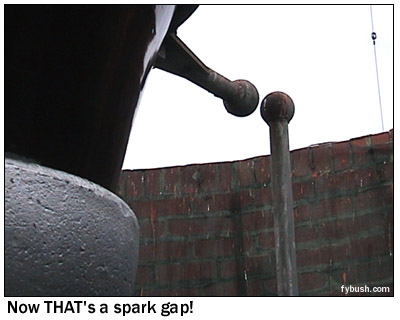
WSM still uses open-wire transmission line to the tower; we follow it out to the big Blaw-Knox (and the little guyed tower that serves as an auxiliary when needed) and the old brick tuning house at the base.
The base of the Blaw-Knox sits in a brick enclosure, and the insulator more or less speaks for itself, doesn't it?
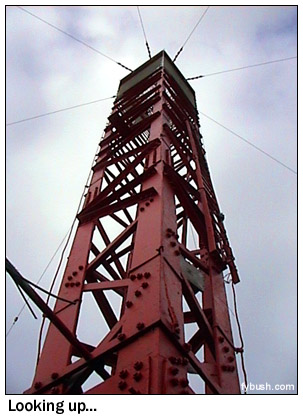 From the very bottom
of the tower, perspective almost erases the diamond shape of
the tower; I've seen pictures taken from the very top, and from
there the shape of the tower is much more obvious!
From the very bottom
of the tower, perspective almost erases the diamond shape of
the tower; I've seen pictures taken from the very top, and from
there the shape of the tower is much more obvious!

This visit was just the beginning of a week-long trip around the south that took us to places such as Chattanooga, Atlanta, Birmingham, Huntsville and back to Nashville to see the rest of the city's broadcast offerings. We'll begin showing you some of those pictures next month - but right now, we're off to collect some trans-Atlantic tower pictures. There will be no new Site of the Week on May 1 or May 8 while we're vacationing in England and France...but check out our Tower Site index to see what you might have missed in recent months, and we'll see you again in three weeks!
Huge thanks to Watt Hairston for spending so much time with us, and to Tom Bryant for arranging the visit. And if you haven't seen Jim Hawkins' excellent Blaw-Knox page, be sure to check it out. (I suspect Jim will be booking tickets to Nashville once he sees this page...)
- Previous Site of the Week: A Rainy Day in Bangor, Maine
- May 15: Chattanooga, Tennessee
- How can you help support Site of the Week? Click here!
- Submit your suggestions for a future Site of the Week!
